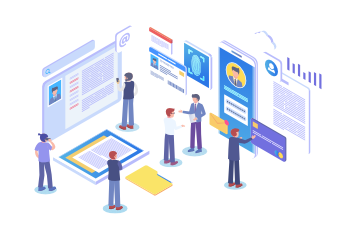Discover Who You Are
As an informaticist, the focus is on information. It can be challenging to distinguish between information technology and informatics as they may appear to be the same. Technology is a tool, or a part, of the informaticist’s approach. However, it’s essential to remember that limiting perspective to technology may result in limited impact within an organization.
Informaticists are employed across many industries, and typically have a broad range of duties that may range from management to highly technical, career specific work. The breadth of knowledge, skills and abilities comes from focus in progressively complex areas of information handling.
Achieving higher levels of capability - and ultimately building a high-performing team or organization - heavily depends on the principles outlined below. Trying to reach higher levels of performance without establishing the foundations will likely lead to failure in terms of information utilization and efficiency.
Building and maintaining a strong hierarchy often takes a team. One may work in a specific area for their entire career as a specialist or spend a few years in each area. Later in their career, an informaticist may work in multiple areas to build high-impact contributions and function as a generalist throughout the hierarchy.
Collection

Data refers to individual elements of information that are combined to form meaningful insights and understanding. Collecting data involves highly technical work at a foundational level, with significant implications for the future efficiency and operation of a team, project, or organization. This process involves focus on structure, modeling, and storage of data.
At this level, several essential activities need to be performed to ensure that the collected data is accurate, reliable, and can be effectively utilized. These activities include:
- Ensuring consistency in data collection, storage, and analysis, so the data can be used to identify patterns and trends.
- Ensuring data availability, so that subject matter experts can access the data they need to perform their tasks efficiently.
- Implementing change control procedures, to manage and track changes to the data over time, verifying data integrity and minimizing errors.
- Documenting the data and the associated processes, so the data can be understood and maintained effectively over time.
- Facilitating future use by using clear and consistent labeling, descriptions, and definitions to minimize confusion and errors.
- Implementing redundancy, to ensure that data is backed up and can be recovered in the event of data loss or system failure.
Protection

When protecting information, the primary focus is on ensuring public safety and information security. This involves performing highly technical work as an advisor and implementer of controls to protect sensitive information. The success of this work is guided by the desire to prevent unintentional accidents and mistakes, minimize barriers to access by subject matter experts, and ensure that legal and ethical boundaries are clear and maintained.
It is of utmost importance that the activities performed at this level are traceable and reviewable. By maintaining a clear record of these activities, organizations can identify potential threats and ensure that they are defended against effectively.
With this mindset, the implementation will naturally reduce and defend against malicious intentions, supporting staff involved in preventing and investigating these activities.
At this level, several critical activities need to be performed to ensure that information is protected effectively. These activities include:
- Contextualizing the information, to understand its sensitivity and identify the appropriate level of protection required.
- Ensuring clarity in communication and documentation, to minimize confusion and ensure that all stakeholders understand the necessary precautions and procedures.
- Maintaining the integrity of the information, to ensure that it remains accurate, reliable, and unaltered.
- Protecting privacy, to ensure that confidential and sensitive information is only accessible to authorized personnel.
- Ensuring accuracy, by verifying the information is correct and relevant, and that it is used appropriately.
- Implementing controls to monitor, restrict and audit access to sensitive information, ensuring that it is only accessible to authorized personnel.
Interaction

When interacting with information, the focus is on the relationships between the public and subject matter experts. This relationship can take many forms, such as a physician and a patient, a meteorologist and an emergency manager, or a teacher and students. This level involves constant evaluation of usability and making improvements where needs are identified. The ultimate goal is to protect relationships and build trust with the public.
At this level, several essential activities need to be performed to ensure that the interaction with information is effective and efficient. These activities include:
- Prioritizing user experience, to ensure that the public can access and understand the information they need easily.
- Facilitating learning, to ensure that the public can learn and engage with the subject matter effectively.
- Building trust with the public, by ensuring that the information provided is accurate, transparent, and easily accessible.
- Focusing on service delivery, to ensure that the public can access the information they need, when they need it, and in a way that is convenient for them.
- Optimizing workflow, to ensure that subject matter experts can deliver their services effectively, and the public can access the information they need efficiently.
Integration

Acting as an integrator requires a high level of technical competency and performance as a prescriber of solutions. Success within this block depends heavily on the establishment and functioning of all previous blocks. The focus is on the big picture view within the organization, and the overall interoperability and architecture of the proposed or existing systems.
- At this level, several critical activities need to be performed to ensure that the organization’s systems are working together effectively. These activities include:
- Selecting and implementing appropriate technologies, to ensure that the systems can work together seamlessly.
- Maintaining and improving the infrastructure, to ensure that it can support the organization’s goals effectively.
- Establishing governance structures, to ensure that the systems are managed effectively and that accountability is clear.
- Optimizing processes, to ensure that the systems are working together efficiently and effectively.
- Structuring the organization, to ensure that the systems are aligned with the organization’s goals and objectives.
Advocacy

Acting as an advocate requires a high level of subject matter expertise in domains such as clinical, biological, or governmental fields. The focus is on advocating for subject matter experts and the public, ensuring that information systems remain relevant to the needs of the team, project, or organization. This level involves active listening, internalization, and communication on behalf of both constituents within the project, team, or organization. Success depends heavily on the establishment and functioning of all previous blocks. Continuously improving, identifying needs, and evaluating outcomes are regular activities to improve service to others.
At this level, several essential activities need to be performed to ensure that the organization is advocating effectively. These activities include:
- Ensuring understanding of the needs of subject matter experts and the public, to ensure that their needs are addressed effectively.
- Maintaining focus on the goals of the project, team, or organization, to ensure that their objectives are being achieved effectively.
- Taking action to address the needs of subject matter experts and the public, to ensure that their needs are met effectively.
- Continuously improving the systems and services, to ensure that they are meeting the needs of subject matter experts and the public effectively.
- Evaluating outcomes to ensure that the systems and services are delivering the desired results.
Staying Grounded
Gather information, assess the state of the environment, and address deficiencies and omissions from the bottom up.
An informaticist will often switch between areas of the hierarchy across a number of projects, which can be mentally and physically challenging, and may be impacted by personnel or organizational changes. For this reason, it is recommended to regularly assess where one is working in the hierarchy on a daily basis and stay grounded in the principles. When working within upper levels of the principles, if you observe struggling projects or teams, it is likely due to oversights or lack of attention to lower levels. When focused on foundational levels, maintain significant caution when undertaking tasks that require principles at the top of the hierarchy.
Lastly, it is important to remember that leadership is not a principle, but an activity that is performed at all levels and all interactions. It does not require a title. Every informaticist has the opportunity to exhibit leadership by modeling the principles and behaviors that support the goals of the organization, and inspire others to improve and contribute their knowledge, skills and abilities.

